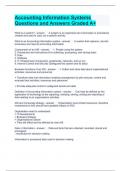-
1. Exam (elaborations) - Ais exam 1 chapters 1-4 questions and answers graded a+
-
2. Exam (elaborations) - Ais exam 1 (ch. 1, 2, 3, 5, 6, 7) questions and answers
-
3. Exam (elaborations) - Ais questions and answers graded a+
-
4. Exam (elaborations) - Ais exam 1 questions and answers 100% correct
-
5. Exam (elaborations) - Ais- chapter 1 questions and answers
-
6. Exam (elaborations) - Ais exam 1 questions and answers
-
7. Exam (elaborations) - Ais final exam questions and answers
-
8. Exam (elaborations) - Ais exam #1 (chapters 1-3) questions and answers
-
9. Exam (elaborations) - Ais chapter 1 questions and answers graded a+
-
10. Exam (elaborations) - Ais exam 1 study guide questions and answers
-
11. Exam (elaborations) - Accounting information systems test 1 questions and answers
-
12. Exam (elaborations) - Ais chapter 1,2,3,4,5,6,7,8,9,10,11,12 questions and answers
-
13. Exam (elaborations) - Accounting information systems (ais) chapters 1-3 questions and answers graded a+
-
14. Exam (elaborations) - Accounting information systems ch. 1 questions and answers graded a+
-
15. Exam (elaborations) - Ais exam 1 questions and answers 100% correct
-
16. Exam (elaborations) - Ais exam review questions and answers
-
17. Exam (elaborations) - Ais exam questions and answers 100% correct
-
18. Exam (elaborations) - Ais exam 1 questions with correct answers
-
19. Exam (elaborations) - Ais exam 1 questions and answers graded a+
-
20. Exam (elaborations) - Ais chapter 1 multiple choice questions and answers
-
21. Exam (elaborations) - Ais questions and answers
-
22. Exam (elaborations) - Ais questions and answers graded a+
-
23. Exam (elaborations) - Ais exam 1 questions and answers
-
24. Exam (elaborations) - Ais midterm questions and answers
-
25. Exam (elaborations) - Ais final exam textbook review questions and answers
-
26. Exam (elaborations) - Unit 1 ais exam questions and answers
-
27. Exam (elaborations) - Chap 1 ais questions and answers
-
28. Exam (elaborations) - Ais discussion questions exam #1 and answers
-
29. Exam (elaborations) - Ais chapter 8 questions and answers
-
30. Exam (elaborations) - Ais final study guide questions and answers graded a+
-
31. Exam (elaborations) - Ais exam 2 study guide questions and answers
-
32. Exam (elaborations) - Ais exam 3 questions and answers graded a+
-
33. Exam (elaborations) - Accounting information systems questions and answers graded a+
-
34. Exam (elaborations) - Ais long answers 15.1 questions and answers 100% correct
-
35. Exam (elaborations) - Ais final exam questions and answers
-
36. Exam (elaborations) - Ais exam 1 question and answers
-
37. Exam (elaborations) - Ais exam #1 questions and answers 100 % correct
-
38. Exam (elaborations) - Ais exam 3 review questions and answers
-
39. Exam (elaborations) - Ais chapter 5 questions and answers graded a+
-
40. Exam (elaborations) - Ais final questions and answers
-
41. Exam (elaborations) - Ais questions and answers 100% correct
-
42. Exam (elaborations) - Ais chapter 10 control & accounting information systems questions and answers
-
43. Exam (elaborations) - Ais exam 1 ch. 1, 2 and 16 questions and answers
-
44. Exam (elaborations) - Ais questions and answers graded a+
-
45. Exam (elaborations) - Ais - exam 2 - ch. 9 ais development strategies questions and answers
-
46. Exam (elaborations) - Ais final questions and answers
-
47. Exam (elaborations) - Ais: chapters 1-4 (missing questions due to images) questions and answers
-
48. Exam (elaborations) - Ais 25 questions with correct answers
-
49. Exam (elaborations) - Ais final exam review questions (extensive)
-
50. Exam (elaborations) - Ais- systems documentation techniques questions and answers correct
-
51. Exam (elaborations) - Ais final exam questions and answers correct
-
52. Exam (elaborations) - Ais ch 1 &2 questions and answers right
-
53. Exam (elaborations) - Ais final questions and answers correct
-
54. Exam (elaborations) - Chapter 10 ais questions and answers right
-
55. Exam (elaborations) - Midterm exam 1: chapters 1-5 ais questions and answers correct
-
56. Exam (elaborations) - Ais chapter 1 questions and answers right
-
57. Exam (elaborations) - Ais quiz 1 ch 1 questions and answers correct
-
58. Exam (elaborations) - Ais chapter 22 questions and answers right
-
59. Exam (elaborations) - Accounting information system (ais) questions and answers correct
-
60. Exam (elaborations) - Ais chapter 1 questions and answers precise
-
61. Exam (elaborations) - Ais quiz 1 questions and answers right
-
62. Exam (elaborations) - Ais application controls questions and answers correct
-
63. Exam (elaborations) - Ais - chapter 1 questions and answers right
-
64. Exam (elaborations) - Chapter 1 (ais exam 1) questions and answers 100% correct
-
65. Exam (elaborations) - Ais - chapter 1 questions and answers graded a+
-
66. Exam (elaborations) - Ais midterm questions and answers correct
-
67. Exam (elaborations) - Ais chapter 7 questions and answers
-
68. Exam (elaborations) - Ais final exam questions and answers graded a+
-
69. Exam (elaborations) - Ais test 1 terms questions and answers right
-
70. Exam (elaborations) - Ais: exam 1 quiz questions and answers correct
-
71. Exam (elaborations) - Ais questions and answers graded a+
-
72. Exam (elaborations) - Ais chapter 1 hall questions and answers 100% correct
-
73. Exam (elaborations) - Ais chapter 5 questions and answers graded a+
-
74. Exam (elaborations) - Ais exam 1 questions and answers correct
-
75. Exam (elaborations) - Ais chapter 2: introduction to transaction processing questions and answers graded ...
-
Show more




